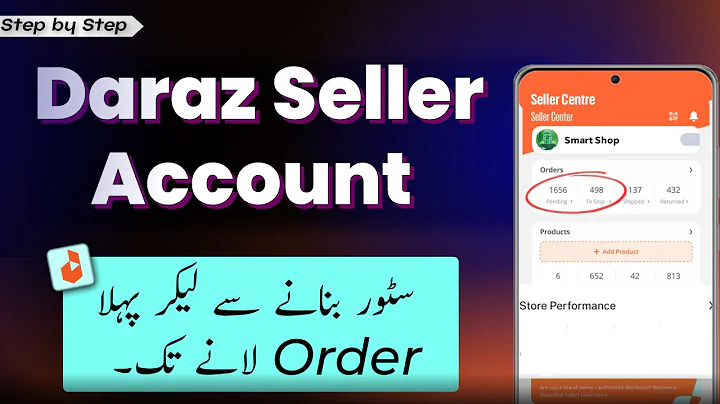Streamline Dropshipping Returns for Higher Profitability
Table of Contents
- Introduction
- Understanding the Importance of Handling Returns in dropshipping
- Factors to Consider when Analyzing Supplier Return Policies
- 3.1 Restocking Fees
- 3.2 Return Window
- 3.3 Replacements and Damaged Items
- 3.4 RMA and Shipping Labels
- Examples of Supplier Return Policies and Where to Find Them
- Determining the Suitability of Suppliers for Handling Returns
- Strategies for Handling Returns on Different Platforms
- 6.1 Amazon
- 6.2 Walmart
- 6.3 eBay
- 6.4 Shopify
- Exploring Alternative Options: Return Centers
- Utilizing Amazon FBA and Walmart Fulfillment Service for Hassle-Free Returns
- Tracking and Managing Returns
- Incorporating Return Costs into Pricing Strategy: Finding Higher Profit Margin Items
- Conclusion
How to Efficiently Handle Returns in Dropshipping
Returns are an inevitable aspect of any e-commerce business, and dropshipping is no exception. In this article, we will dive into the intricacies of handling returns in the context of wholesale dropshipping. We will explore the factors to consider when analyzing supplier return policies, provide examples of such policies, and discuss strategies for effectively managing returns on different platforms. Additionally, we will explore alternative options such as return centers and highlight the benefits of utilizing services like Amazon FBA (Fulfillment by Amazon) and Walmart Fulfillment Service. We will also touch upon the importance of tracking and managing returns and discuss how to incorporate return costs into your pricing strategy by finding higher profit margin items. By the end of this article, you will have a comprehensive understanding of how to efficiently handle returns in your wholesale dropshipping business.
1. Introduction
Welcome to the world of wholesale dropshipping! As an aspiring entrepreneur, you have ventured into the realm of online retail, where the possibilities are endless. However, with every lucrative opportunity comes its fair share of challenges. One such challenge is dealing with returns. Returns can be a significant point of frustration for dropshippers, as they involve multiple parties and complicated logistics. In this article, we will guide you through the process of handling returns, specifically in the context of wholesale dropshipping. So, let's dive in and discover the best practices for effectively managing returns in your business.
2. Understanding the Importance of Handling Returns in Dropshipping
Returns are an integral part of any e-commerce business, and dropshipping is no exception. As a dropshipper, you rely entirely on your suppliers for fulfillment, warehousing, and, yes, returns. This is why it is crucial to understand and establish solid return policies with your suppliers. While returns can be a hassle, it is in your best interest to handle them efficiently and ensure customer satisfaction. By prioritizing returns, you demonstrate your commitment to providing a positive buying experience, which can help build trust and loyalty among your customer base.
3. Factors to Consider when Analyzing Supplier Return Policies
When evaluating potential suppliers for your wholesale dropshipping business, it is essential to closely examine their return policies. These policies will serve as the foundation for how you handle returns in your own business. Let's delve into the key factors you should consider when analyzing supplier return policies:
3.1 Restocking Fees
Restocking fees are charges imposed by suppliers to process returns. They typically range from 10% to 20% of the wholesale price. It is crucial to be aware of these fees as they directly impact your profitability. A lower restocking fee may be more favorable, especially if returns are frequent in your business. However, if the fee is too high, it may be more cost-effective to manage returns yourself.
3.2 Return Window
The return window refers to the timeframe in which customers can return a product after purchase. It is essential to align the supplier's return window with the return policies of the platforms you sell on, such as Amazon or eBay. For example, if a supplier has a return window of 14 days but the platform allows returns up to 30 days, this discrepancy may lead to customer dissatisfaction and potential financial losses.
3.3 Replacements and Damaged Items
It is crucial to clarify how suppliers handle replacements and damaged items. Will they provide replacements for defective products? Do they require an RMA (Return Merchandise Authorization) for returns? As a dropshipper, these details are vital to ensure a smooth return process and minimize customer inconvenience.
3.4 RMA and Shipping Labels
An RMA is a unique number assigned to a return, allowing suppliers to identify and process it efficiently. Some suppliers may require a customer to use an RMA when initiating a return. Additionally, suppliers may provide their own shipping labels for returns. If you sell on platforms like Walmart with automatic returns, understanding whether your supplier accommodates these requirements is crucial to avoid any complications.
4. Examples of Supplier Return Policies and Where to Find Them
To gain a better understanding of how supplier return policies are typically structured, let's examine some examples. Return policies are often found in the footer or specific pages on supplier websites. For example, CTW has a dedicated page labeled "Returns." Similarly, Sagebrook Home provides shipping and returns information on their website. However, some suppliers may not explicitly list return policies, in which case you will need to contact them directly to inquire about their specific policies. Take the time to review these policies and clarify any uncertainties before establishing a partnership.
5. Determining the Suitability of Suppliers for Handling Returns
Once you have thoroughly analyzed your potential suppliers' return policies, you can determine if they are a good fit for your business. Consider factors such as restocking fees, return windows, the handling of damaged items, and the requirement of RMAs and shipping labels. By assessing these aspects, you can ensure that your suppliers' policies align with your overall return management strategy.
6. Strategies for Handling Returns on Different Platforms
As a dropshipper, you are likely selling on various platforms, each with its own rules and requirements regarding returns. Let's explore strategies for effectively handling returns on some of the most popular platforms:
6.1 Amazon
Amazon has recently introduced automatic prepaid returns, making returns more seamless for customers. To effectively handle returns on Amazon, you can set up your supplier's address as a return warehouse center. By correctly linking your supplier's address with each listing, Amazon will automatically generate and issue return labels to customers, ensuring the item is returned to the supplier's address. If permitted, you can also charge restocking fees to cover return costs.
6.2 Walmart
Similar to Amazon, Walmart offers automatic returns. To manage returns on Walmart, you can follow a similar approach by setting up your supplier's address as the return warehouse. However, it is important to note that Walmart does not allow restocking fees. Ensure your supplier's return policies align with Walmart's requirements to avoid any conflicts.
6.3 eBay
eBay provides more flexibility in handling returns by allowing you to upload your own return label. When a customer initiates a return, you can coordinate with your supplier to approve the return and generate a shipping label. You can then upload the label to eBay, simplifying the return process. This approach gives you greater control and ensures returns are handled according to your supplier's policies.
6.4 Shopify
If you have your own website using the Shopify platform, you have the freedom to set your own policies for returns. Take advantage of this flexibility by establishing clear return guidelines that align with your supplier's policies. Keep in mind the requirements of your chosen shipping carriers to ensure a seamless return process.
7. Exploring Alternative Options: Return Centers
Another option for handling returns is partnering with a return center. Return centers act as fulfillment centers specifically designed to handle returns on behalf of businesses. Instead of using your supplier's address as the return warehouse, you can set up the return center's address. When a return is initiated, the item will be sent to the return center for processing. You can then decide whether to have the item shipped back to your supplier, yourself, or take any other necessary action. Return centers offer a streamlined and centralized solution for managing returns efficiently.
8. Utilizing Amazon FBA and Walmart Fulfillment Service for Hassle-Free Returns
To simplify your return management process, consider utilizing Amazon FBA or Walmart Fulfillment Service (WFS). With these services, you can send your inventory directly to Amazon or Walmart, respectively. They will handle shipping, returns, and even customer service on your behalf. By leveraging these services, you can offload the responsibility of managing returns to industry giants who have dedicated systems in place for efficient returns handling.
9. Tracking and Managing Returns
Tracking and managing returns is essential for maintaining visibility and control over your inventory and finances. Keep a detailed spreadsheet or use software to track returns, including tracking numbers, costs, and whether the item has been returned to the supplier. This information will help you reconcile refunds, evaluate supplier performance, and identify any trends or issues that may arise.
10. Incorporating Return Costs into Pricing Strategy: Finding Higher Profit Margin Items
Returns incur costs, so it is vital to factor these costs into your pricing strategy. Look for higher-priced items with better profit margins to offset the costs associated with returns. Conduct thorough market research to find profitable products and suppliers that offer competitive pricing, while still meeting your standards for quality and customer satisfaction.
11. Conclusion
Handling returns in your wholesale dropshipping business can be daunting, but by incorporating the strategies outlined in this article, you can streamline the process and ensure customer satisfaction. Remember to thoroughly analyze supplier return policies, establish clear return guidelines, leverage platform-specific strategies, track returns diligently, and adjust your pricing strategy accordingly. By prioritizing returns management, you can build trust, mitigate financial losses, and foster long-term success in your dropshipping venture.
Highlights:
- Analyzing supplier return policies is crucial for successful returns management in dropshipping.
- Restocking fees, return windows, handling damaged items, and RMA requirements are essential factors to consider when assessing supplier return policies.
- Different platforms, such as Amazon, Walmart, eBay, and Shopify, have varying return processes and requirements.
- Return centers provide an alternative solution for efficient returns handling in dropshipping.
- Leveraging Amazon FBA and Walmart Fulfillment Service can alleviate the burden of return management.
- Tracking and managing returns through spreadsheets or software is vital for financial control and supplier evaluation.
- Incorporating return costs into your pricing strategy is essential to maintain profitability in the face of returns.
FAQ
Q: Can I charge restocking fees to customers on all platforms?
A: No, restocking fees are not allowed on platforms like Walmart. However, platforms like Amazon do allow restocking fees, which can help recoup return costs.
Q: Are return policies the same for all suppliers in wholesale dropshipping?
A: No, return policies can vary greatly among suppliers. It is essential to review and clarify the return policies of each supplier to ensure they align with your business requirements.
Q: How can I handle returns if my supplier requires an RMA or their own shipping label?
A: If your supplier requires an RMA or their own shipping label, you may need to find workarounds or explore alternative options, such as partnering with a return center or using FBA/WFS services.
Q: How can I incorporate return costs into my pricing strategy without compromising profitability?
A: By focusing on higher-priced items with better profit margins, you can offset the costs associated with returns. Thorough market research and supplier selection are crucial for finding profitable products in wholesale dropshipping.



















